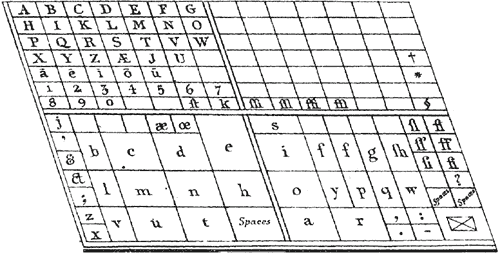 ‘Thou hast caused
‘Thou hast causedprinting
to be used’
Jack Cade shares his grievances with Lord Say, Henry VI Part II.
Shakespeare & Foul Cases
Printing historian William Blades' book, ‘Shakspere and Typography’ may be a century out of date, but it's a very interesting read.
Most of the book covers the possible printing references found in Shakespeare's works and speculates how he may have learned the terms of the trade, but perhaps the most important aspect of Blades' research is hidden away at the back.
Errors from a Foul Case
As you probably know, a ‘foul case’ is a type-case in which a substantial number of the sorts (pieces of type) have been returned to the wrong boxes.
These errors are easily transferred into the text, when setting type, and some may go unnoticed by the compositor.
Blades thinks this could be more than just a minor annoyance:
If we can discover any law which governs this abnormal position of the types — if, for instance we can predict that the letter o, when away from its own will more often be found in the box appropriated to a, than any other — that b has a general tendency to visit the l box, and l the v box — and that d, if away from home will be almost certainly found among the n's; if we can show this, we shall then lay a good foundation for the re-examination of many corrupt or disputed readings in the text of Shakspere, some of which may receive fresh life from such a treatment.
He goes on to explain the main reason why cases become fouled.
The chief cause of a "foul" case was the same in Shakspere's time as now. […] Suppose a compositor at work "distributing;" the upper and lower cases, one above the other, slant at a considerable angle towards him, and as the types fall quickly from his fingers they form conical heaps in their respective boxes, spreading out in a manner very similar to the sand in the lower half of an hour-glass. Now, if the compositor allows his case to become too full, the topmost letters in each box will certainly slide down into the box below, and occasionally, though rarely, into one of the side boxes. When such letters escape notice, they necessarily cause erroneous spelling, and sometimes entirely change the meaning of a sentence.
The Foul Case in Action
Some of the passages Blades suggests seem plausible victims of foul cases.
In Henry VI:
I come to thee for charitable License,
That we may wander ore this bloody field,
To booke our dead, and then to bury them
Where looke may have morphed into booke. In Troilus and Cressida:
With this cramm'd reason: reason and respect
Make livers pale and lustihood deject.
Where the suggested error is livers instead of lovers. And when Helena, in All's Well That Ends Well, says:
Our wagon is prepared, and time revives us:
All's well that ends well; still the fine's the crown;
Whate'er the course, the end is the renown.
Blades quite convincingly maintains that it should read time reviles.
There are plenty of contentious suggestions in the book. For instance, Blades seems quite sure that the coigns mentioned in Pericles are the quoins used in letterpress to hold type securely in the chase:
‘By the four opposing coigns
Which the world together joins’
Other scholars suggest that Shakespeare was just using a common synonym for corner to make a tidy rhyme with joins.
Continuing the Work
Has anyone continued Blades' work in this area? We don't know.
He was a printer himself and the book is, understandably, narrowly focused. We're concerned that this bias has prevented the Typographical Errors section from being taken as seriously as it should.
Any letterpress printer can see immediately that Blades is on to something – and something not only relevant to Shakespeare but to all works originally letterpress printed – but how many Shakespearean scholars today have dissed type themselves?
Contemporary Case Lay
If you're a lay-person who needs a little more convincing, look at this illustration (originally published in Moxon's Mecahnick Exercises, 1683) of the layout of a type-case, below. Remembering that the type tends to find its way into the box below its rightful home, or nearby, these are the letters in question in the quotations above:
| booke | > | looke | : | b | > | l |
| livers | > | lovers | : | i | > | o |
| revives | > | reviles | : | v | > | l |

You Might Also Like...
